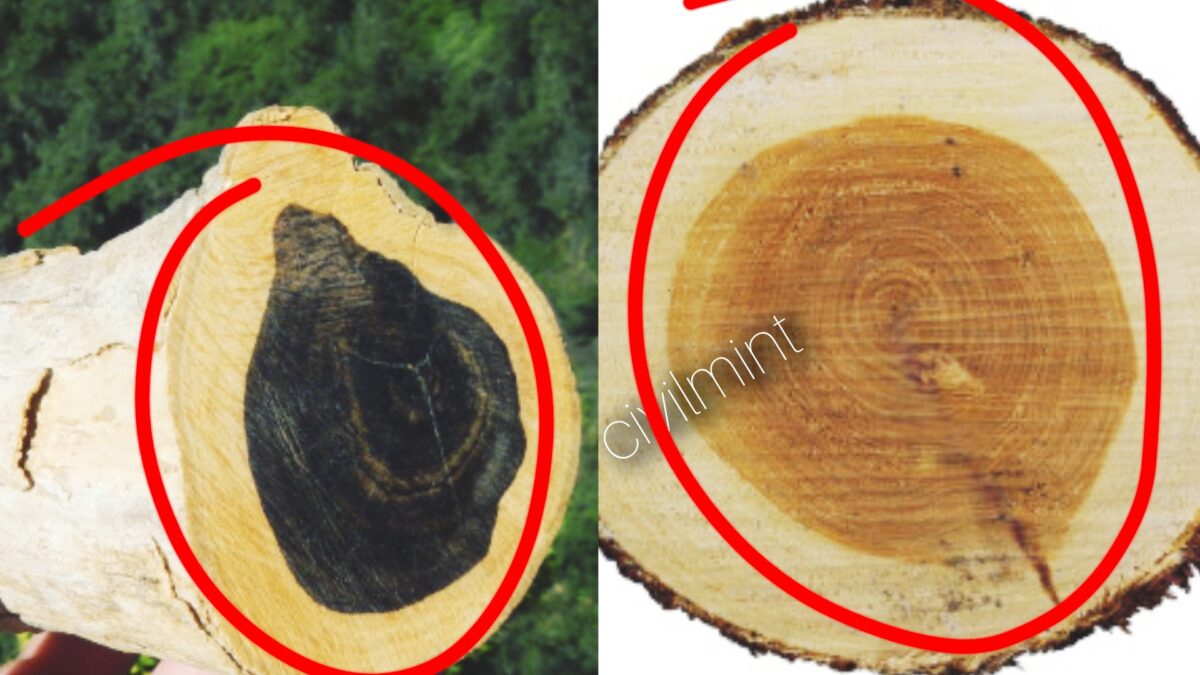The key difference between heartwood and sapwood is that heartwood is the inner, older, and non-living part of a tree trunk, providing structural support, while sapwood is the outer, younger, and living part responsible for transporting water and nutrients.

Table of Contents
Heartwood Vs Sapwood: All Differences
Here are all the differences between Heartwood and Sapwood.
| Heartwood | Sapwood |
|---|---|
| Found in the center of the tree trunk | Found near the outer part of the tree trunk |
| Darker in color | Lighter in color |
| Hard and strong | Softer and less strong |
| Doesn’t transport water and nutrients | Transports water and nutrients |
| Provides support to the tree | Helps in growing new parts of the tree |
| Protects the inner part of the tree | Acts as a passage for water and nutrients |
| Resistant to decay and insects | More susceptible to decay and insects |
| Doesn’t have living cells | Contains living cells |
| Contains natural chemicals for protection | Doesn’t have as many protective chemicals |
| Has rings that show age and growth | Doesn’t have clear rings to show age |
| Made up of older and inactive cells | Made up of younger and active cells |
| Less likely to be damaged or injured | More likely to be damaged or injured |
| Used by the tree for long-term support | Used by the tree for immediate needs |
| Helps the tree stay upright | Helps the tree grow and expand |
| Provides stability and strength | Allows flexibility and growth |
| Doesn’t conduct water and nutrients | Conducts water and nutrients |
| Provides a natural color to wood | Doesn’t contribute to the wood color |
| Used in making furniture and flooring | Not usually used for making furniture or flooring |
| Gives a darker tone to the wood | Gives a lighter tone to the wood |
| Used for carving and decorative purposes | Not commonly used for carving or decoration |
| Takes longer to dry when cut | Dries faster when cut |
| Gives the tree its characteristic smell | Doesn’t have a distinct smell |
| Less likely to be affected by temperature | More sensitive to changes in temperature |
| Harder to work with when crafting | Easier to work with when crafting |
| Lasts longer when exposed to the elements | More likely to decay when exposed to elements |
| Used in making musical instruments | Not commonly used in making musical instruments |
| Gives strength to the tree trunk | Helps in the growth of leaves and branches |
| Contains resins and oils | Doesn’t contain as many resins and oils |
| Provides a natural beauty to wood | Doesn’t contribute to the wood’s beauty |
| Takes longer to burn in a fire | Burns more easily in a fire |
| Found in the older parts of the tree | Found in the younger parts of the tree |
What Is Heartwood?
Heartwood is the innermost part of a tree trunk that surrounds the pith. It is compact, strong, durable and darker in color than the outer layers. The size of the heartwood increases with the size and age of the tree.

The percentage of moisture in the middle part of the heartwood is very less. It provides the best timber for engineering work and construction. The lower moisture content in the heartwood makes it less susceptible to decay and fungal attack, which contributes to its durability.
The heartwood is highly valued for a variety of applications, particularly in engineering work and construction. It provides reliable support and stability in engineering projects such as the construction of buildings and bridges. Its deep color and unique grain pattern make it aesthetically appealing for decorative and fine woodworking.
Some trees have a large proportion of heartwood relative to sapwood, while others have uniform wood composition throughout the trunk. The specific properties of heartwood can also vary depending on factors such as tree species, environmental conditions, and growth factors.
What Is Sapwood?
Sapwood is the living, younger part of the wood located just beneath the bark, which lies between the heartwood and the cambium layer of a tree trunk or branch. It serves a vital role in the transportation of water and nutrients through the tree.

The sapwood is lighter in weight, softer, and weaker compared to the heartwood. It contains a higher percentage of moisture, making it more susceptible to bending and deflection. Due to these characteristics, sapwood is generally considered less desirable for commercial purposes.
In woodworking and construction applications, sapwood is often removed or treated to improve the durability and strength of wood products. This is because the heartwood, which is denser and more resistant to decay and insects, is preferred for its enhanced properties.
Sapwood plays an important role in the growth and development of trees, it is typically not used extensively for commercial purposes due to its relatively lower strength and increased moisture content.
Faqs
Heartwood is the hard, dark part inside a tree trunk, while sapwood is the softer, light-colored outer part.
Heartwood is tough and protects the tree, while sapwood carries water and food to help the tree grow.
Heartwood gets its dark color from special substances inside, while sapwood is lighter because it has more water.
Yes, heartwood looks darker and has strong patterns, while sapwood is lighter and has a softer look.
Heartwood is used for strong things like furniture and floors, and sapwood is used for lighter things like cabinets and walls.
